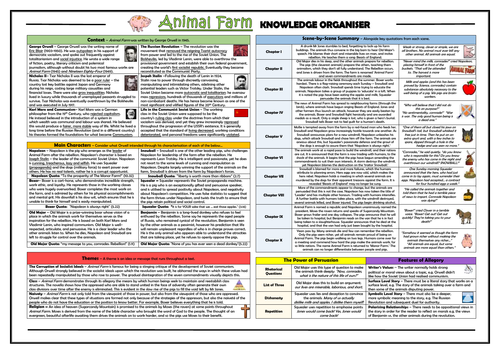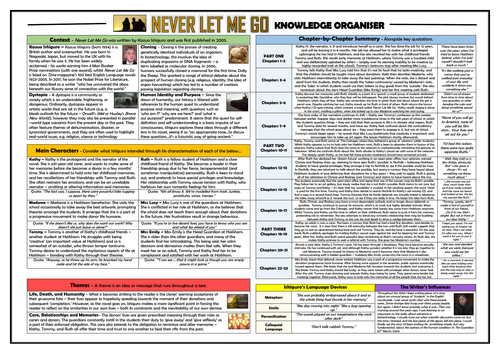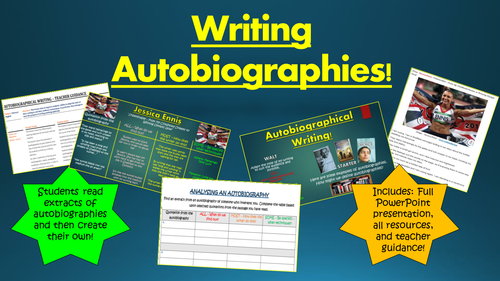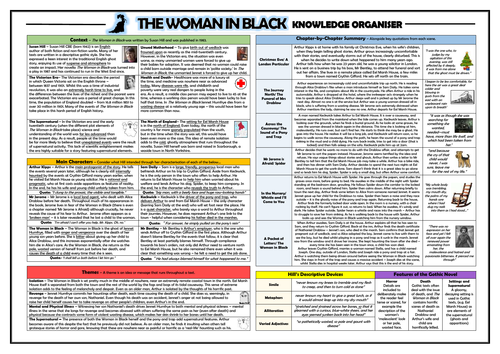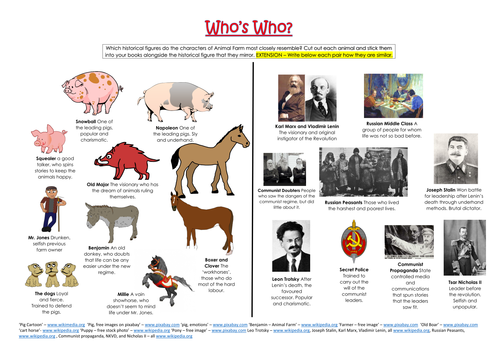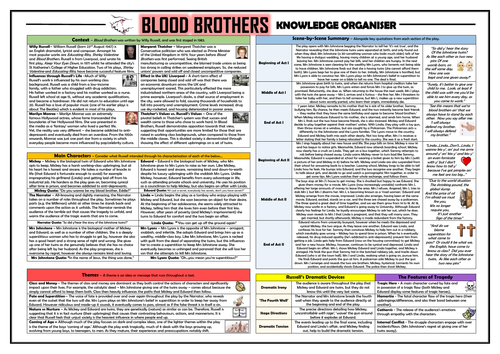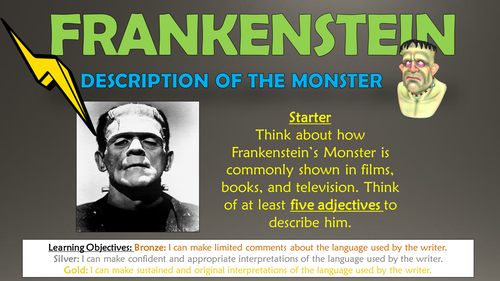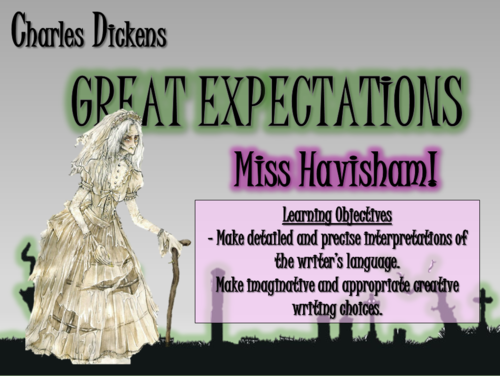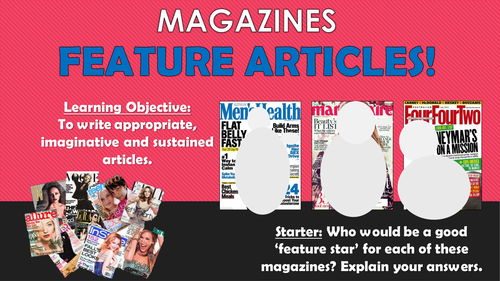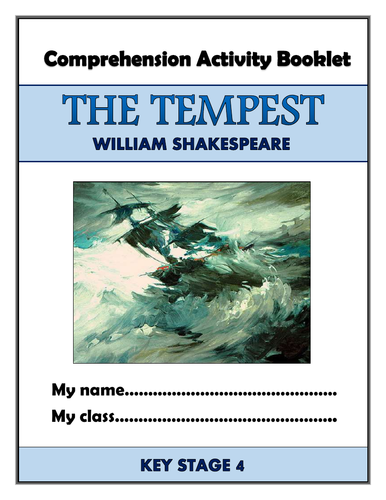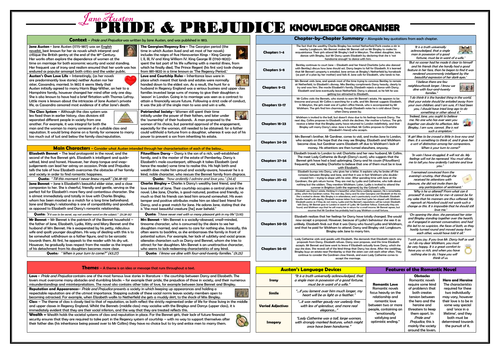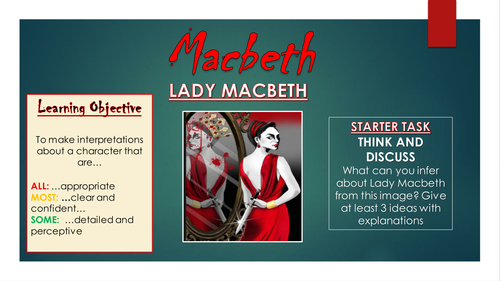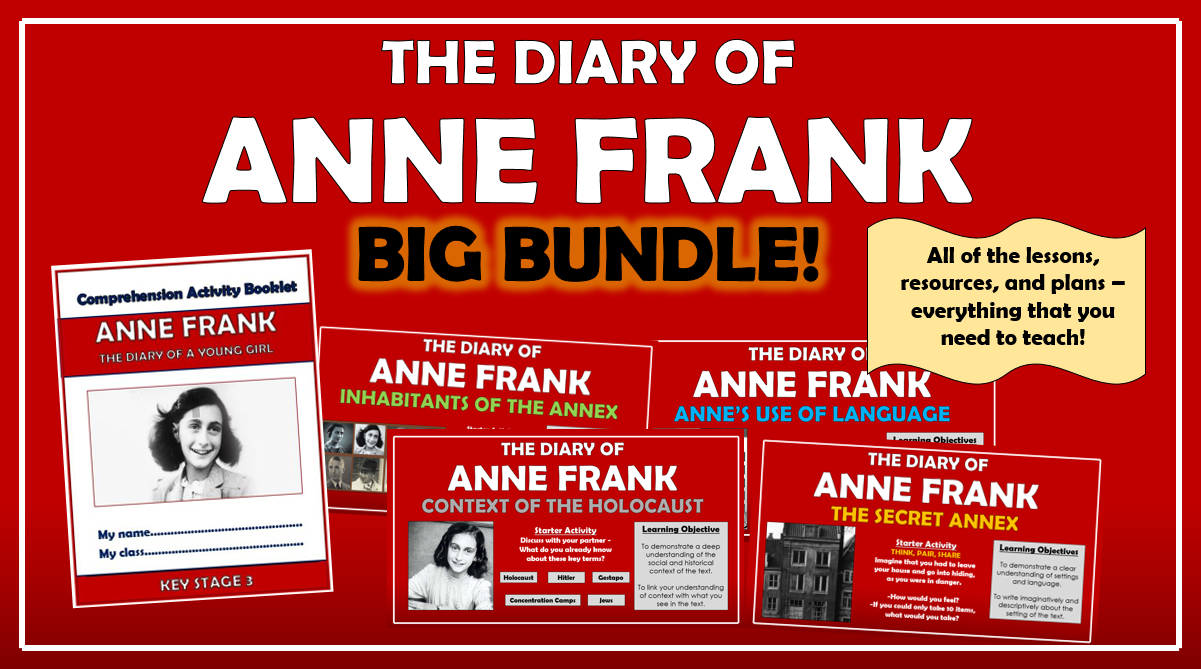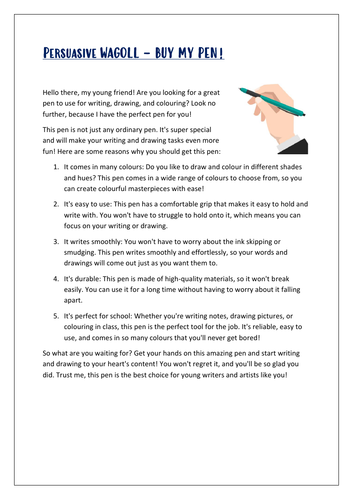
3k+Uploads
1925k+Views
2250k+Downloads
English language arts

Animal Farm Knowledge Organiser/ Revision Mat!
This detailed and visually-appealing resource offers a complete reference point for students learning or revising George Orwell's 'Animal Farm.' It contains comprehensive sections on:
- Context;
- Chapter by Chapter Summary (with quotes);
- Main Characters;
- Themes;
- Features of Allegory;
- 'The Power of Persuasion (in the speeches of Old Major and Squealer).
Key words and ideas are underlined for easy reference. The resource is designed to be printed onto A3, and is provided as both a PDF and a Word version (so that you can edit if you want to). All images used are licensed for commercial use and are cited on a separate document (included).

Never Let Me Go Knowledge Organiser/ Revision Mat!
This detailed and visually-appealing resource offers a complete reference point for students learning or revising Kazuo Ishiguro’s ‘Never Let Me Go.’ It contains comprehensive sections on:
Context;
Chapter by Chapter Summary (with quotes);
Main Characters;
Themes;
Ishiguro’s Language Devices;
Influences on the Writer.
Key words and ideas are underlined for easy reference. The resource is designed to be printed onto A3, and is provided as both a PDF and a Word version (so that you can edit if you want to). All images used are licensed for commercial use and are cited on a separate document (included).

Writing Autobiographies!
This stimulating and informative lesson aims to improve students’ ability to adapt the style of their writing to suit their audience and purpose. In particular, they attempt to meet the purpose of writing autobiographically.
Students follow a clear and logical learning journey, in which they:
-Define autobiographies and their key features;
-Read extracts of autobiographies, and analyse the language techniques used;
-Use independent learning skills to analyse an autobiography of their choice;
-Create a success criteria for effective autobiography writing (although a ready-made success criteria is included)
-Write a section of their own autobiography, using the techniques that they have learnt;
-Peer/self-assess their autobiographical attempts.
There are enough resources here really for two lessons, including:
-Visually engaging whole-lesson PowerPoint;
-Autobiography extract;
-Analysing Autobiographies template;
-Success Criteria;
-Step-by-step lesson plan.
All images are licensed for commercial use, and are cited on the final page of the slide.

The Woman in Black Knowledge Organiser/ Revision Mat!
This detailed and visually-appealing resource offers a complete reference point for students learning or revising Susan Hill’s ‘The Woman in Black.’ It contains comprehensive sections on:
Context;
Chapter by Chapter Summary (with quotes);
Main Characters;
Themes;
Hill’s Language Devices;
Features of Gothic Novels.
Key words and ideas are underlined for easy reference. The resource is designed to be printed onto A3, and is provided as both a PDF and a Word version (so that you can edit if you want to). All images used are licensed for commercial use and are cited on a separate document (included).
Bundle Sale

Julius Caesar - William Shakespeare - Big Bundle!
THIS BUNDLE CONTAINS ALL OF THE JULIUS CAESAR LESSONS, IN ADDITION TO THE COMPREHENSION ACTIVITY BOOKLET, AND THE JULIUS CAESAR KNOWLEDGE ORGANISER!
This engaging, varied, and informative scheme of learning is designed to help students gain understanding, assessment skills, and key interpretations of William Shakespeare’s ‘Julius Caesar.’ Made up of a wide-range of interesting and exciting lessons, students should complete this scheme having gathered vital skills in: interpreting the significant meanings of the play, understanding the writer’s ideas within the play, analysing key characters, settings, and themes, and understanding Shakespeare’s language devices.
Included is:
Julius Caesar Knowledge Organiser
Julius Caesar Comprehension Bundle
…and the lessons…
-Understanding Historical Context;
-Act 1 Scene 1 - The Play Opening;
-Act 1 Scene 2 - The Feast of Lupercal;
-Act 3 Scene 1 - The Assassination Scene;
-Act 3 Scene 2 - Mark Antony’s Speech;
-Act 4 Scene 3 - The Ghost of Caesar;
-Act 5 Scene 5 - Brutus: The Tragic Hero.
Stimulating, visual, and easily adaptable, these lessons provide suggested learning objectives and outcomes for students of a wide-range of abilities - The vast majority of tasks are differentiated to allow for different abilities and needs in your classroom. Each lesson loosely follows this logical learning journey to ensure that students learn in bite-size steps:
Engaging
Defining/ Understanding
Identifying/Remembering
Analysing/ Creating
Peer or self evaluating.
All of the lessons are interactive, employ a variety of different teaching and learning methods and styles, and are visually-engaging. Resources, worksheets, and lesson plans are all provided.
Bundle Sale

Cirque Du Freak Huge Bundle!
THIS BUNDLE CONTAINS ALL OF THE CIRQUE DU FREAK LESSONS, IN ADDITION TO THE COMPREHENSION BOOKLET AND THE POINTLESS GAME!
This engaging, varied, and informative scheme of learning is designed to help students gain understanding, assessment skills, and key interpretations of Darren Shan’s ‘Cirque Du Freak.’ Made up of a wide-range of interesting and exciting lessons, students should complete this scheme having gathered vital skills in: interpreting the significant meanings of the text, understanding the writer’s ideas within the text, identifying the traits of key characters, settings, and themes, and understanding language devices.
Stimulating, visual, and easily adaptable, these lessons provide suggested learning objectives and outcomes for students of a wide-range of abilities - The vast majority of tasks are differentiated to allow for different abilities and needs in your classroom. Each lesson loosely follows this logical learning journey to ensure that students learn in bite-size steps:
- Engaging
- Defining/ Understanding
- Identifying/Remembering
- Analysing/ Creating
- Peer or self evaluating.
All of the lessons are interactive, employ a variety of different teaching and learning methods and styles, and are visually-engaging. Resources, worksheets, and lesson plans are all provided.

Animal Farm: Old Major's Dream and The Revolution!
These resources enable students to understand and analyse the Old Major’s dream and the events of the animal revolution, in the opening two chapters of George Orwell’s Animal Farm. More precisely, students learn to make clear and accurate interpretations about events and characters, with appropriate links to the Orwell’s allegory and relationship to context.
Students learn through the following tasks:
- Gauging and collaborating previous knowledge through a discussion-based starter task;
- Reading the first two chapters and demonstrating their understanding through a related activity sheet;
- Developing their understanding of characters and context through a a making links activity;
- Analysing the allegorical nature of the opening chapters by further exploring the connections between characters and contexts;
- Peer assessing their partners' learning attempts.
The following resources are provided:
- Engaging and colourful step-by-step PowerPoint (includes links for video)
- Teacher lesson guidance/plan;
- Chapters 1 and 2 worksheet;
- Making Links Activity Sheet (1x more difficult, 1 x easier);
- Copies of Chapters 1 and 2.
All images and videos are licensed for commercial use, and are cited on the final slide of the PowerPoint. Note - internet connection is needed if you plan to use the video.

Of Mice and Men - The Themes of Dreams and Loneliness
This engaging and interesting lesson aims to improve students' knowledge of the main themes (Dreams and Loneliness) in John Steinbeck's Of Mice and Men. It also aims to build their skills in retrieving information from texts, understanding the writer's ideas and opinions, and making precise and confident interpretations about texts.
The lesson uses a range of tasks, that require students to use their visual and interactive skills. It follows this learning journey:
- Understanding what dreams and loneliness are, and how we each experience them;
- Defining themes and understanding how writers use them;
- Understanding how and why themes are used in other famous texts;
- Retrieving evidence from the text to demonstrate where the characters experience dreams and loneliness;
- Analysing how the themes are used to help get across John Steinbeck's ideas about 1930s America;
- Evaluating each others' analytical attempts.
The resource includes a comprehensive and visually engaging PowerPoint presentation, a worksheet for recording the retrieved quotations, a helpful template for the main task, and a lesson plan/ teacher guidance sheet.
All images in this resource are licensed for commercial use, and are cited on the final slide of the lesson presentation.
You can choose to buy this resource alone, or as part of the 'Of Mice and Men - All Lessons and Scheme' bundle, which contains seven full lessons, resources, teachers notes, and PowerPoint presentations, plus a Pointless Of Mice and Men game, for just £5!

The Merchant of Venice - Act 4 Scene 1 - The Courtroom Scene!
This engaging and informative lesson enables students to make clear, detailed and well-informed interpretations of Act IV Scene I of The Merchant of Venice. In particular, students develop their understanding of the key events/ implications of the scene, identify and analyse the language devices used by Shakespeare within key quotations from the scene, and consider the effect of these choices on Shakespearean audiences.
The lesson follows a step-by-step learning journey, in which children learn through:
Engage with an artist’s impression of the courtroom scene, honing their skills of inference and deduction;
Reading and comprehending the main events and meanings in the courtroom scene;
Identifying and analysing Shakespeare’s use of language through examples of Portia and Shylock lines in the scene;
Considering Shakespeare’s intentions and the Shakespearean audiences reactions to the scene;
Self assessing their learning through the lesson;
Included is:
Whole lesson PowerPoint - colourful and comprehensive;
Language devices cards for the card-sorting activity;
Key quotations cards;
Copy of Act IV Scene I;
Shakespeare’s Intentions/ Audience Reactions template;
Comprehensive lesson plan.
Resources are provided in PDF (to maintain formatting), Word (so that they are easily editable) and also in zipfiles.
The lesson contains opportunities for group learning, speaking and listening, peer assessment, and whole class discussion. I originally used these resources with year 10 and 11 classes, however colleagues have used them for between year 9 and year 13 with some adaptations.
All images are licensed for commercial use, and image rights are listed on the last page of the presentation.

Blood Brothers Knowledge Organiser/ Revision Mat!
This detailed and visually-appealing resource offers a complete reference point for students learning or revising Willy Russell’s ‘Blood Brothers.’ It contains comprehensive sections on:
Context;
Scene by Scene Summary (with quotes);
Main Characters;
Themes;
Russell’s Dramatic Devices;
The Features of Tragedy.
Key words and ideas are underlined for easy reference. The resource is designed to be printed onto A3, and is provided as both a PDF and a Word version (so that you can edit if you want to). All images used are licensed for commercial use and are cited on a separate document (included).

Frankenstein: Shelley's Description of the Monster!
This lesson aims to improve students’ understanding of the descriptive language used to depict the monster in Chapter 5 of Mary Shelley’s horror novel 'Frankenstein.' The lesson places a particular focus upon the descriptive language devices employed by Shelley, in order to create a clear image of the monster’s appearance in the reader's mind, and also to describe Victor’s strong reaction to his creation. By the end of the lesson, students demonstrate an ability to make sustained and original interpretations of the language used by the author.
The lesson follows a step-by-step learning journey, in which children learn through:
- Considering how their preconceptions about the monster have been influenced by modern media and representations;
- Read and understand a key extract from the beginning of chapter 5 - the point at which the monster comes to life;
- Infer and interpret the key developments of the extract, including Frankenstein's changing feelings and the monster's ambiguous actions;
- Identifying and analysing some of the key descriptive devices used by Shelley to create an image of the monster;
- Analysing the effect of the descriptive devices upon the reader;
- Peer assessing each other's learning attempts.
Included is:
- Whole lesson PowerPoint - colourful and substantial; (including an animated Frankenstein's monster to guide them through the lesson);
- Descriptive devices worksheet (and a teacher answer sheet);
- Extract from the beginning of Chapter 5;
- Inferring and Interpreting worksheet;
- Analysis template with success criteria for creating well-structured responses;
- Comprehensive lesson plan.
There are also opportunities for group learning, peer assessment, and whole class discussion. This was originally taught to middle-ability year 9/10 groups, but can easily be differentiated for groups of different ages and abilities.
All images are licensed for commercial use, and image rights are listed on the last page of the presentation.

Great Expectations: Miss Havisham!
This engaging and informative lesson enables students to make detailed and precise interpretations of the language used by Charles Dickens in describing Miss Havisham in Great Expectations. In particular, students analyse the interesting vocabulary choices, similes, metaphors, and other language devices employed to depict Miss Havisham’s decayed appearance and surroundings, before utilising the techniques in a similar manner through their own vivid descriptions.
The lesson follows a step-by-step learning journey, in which children learn through:
- Defining and exemplifying each of the descriptive language devices;
- Reading extracts from 'Great Expectations' in which Miss Havisham is described, identifying the descriptive devices used;
- Precisely and in detail, analysing how Dickens uses each of the descriptive language devices for effect;
- Creating their own imaginative and appropriate descriptions of mysterious characters, using a wide range of descriptive language devices;
- Peer assessing each other's learning attempts.
Included is:
- Whole lesson PowerPoint - colourful and comprehensive;
- Extracts from Great Expectations;
- Cards for card-sorting activity;
- Analysis template with success criteria for creating well-structured responses;
- Blank character profile template;
- Model example character profile template;
- Writing to describe helpsheet;
- Comprehensive lesson plan.
All documents are attached as Word and PDF in case formatting differs on your computer.
There are also opportunities for group learning, peer assessment, and whole class discussion. This was originally taught to mixed ability year 10 groups, but can easily be differentiated for groups of different ages and abilities.
All images are licensed for commercial use, and image rights are listed on the last page of the presentation.

Magazines - Writing Feature Articles!
This lesson enables students to plan and create their own interesting, detailed, and imaginative feature articles. Through analysing existing feature articles, and noting their features of subject matter, language, and structure, students create articles that are highly appropriate to the genre and audiences of different magazines.
Over the course of their learning journey, students:
- Define and exemplify what feature articles are;
- Identify and understand the different language and subject matter elements are within feature articles;
- Analyse the language techniques and structures used within a model example of a feature article;
- Write their own imaginative and appropriate front covers;
- Peer and self assess each other's front cover attempts.
The resources include:
-Visually engaging whole-lesson PowerPoint;
-A colourful and clear helpsheet for writing to explain;
-Template for planning feature articles;
-Andy Murray feature article for analysis;
-Helpful and comprehensive step-by-step lesson plan.
All images are licensed for commercial use, and are cited on the final page of the slide. NOTE - Internet access is preferable for the planning task.

The Tempest Comprehension Activities Booklet!
This resource booklet contains a wide range of age-appropriate, engaging, and meaningful comprehension activities for use throughout the reading of William Shakespeare’s ‘The Tempest.’ Teachers have found them particularly useful in exam revision, comprehension tasks, or guided reading sessions. They are perfect for aiding the progress of students towards meeting the KS4 expectations within the new National Curriculum framework - this makes the tasks suitable for all examining bodies. Students have found these resources extremely engaging, and for teachers there is explicit information within each task regarding which comprehension strands the task is designed to demonstrate. They also relate to key extracts, characters, and themes from the play ensuring that students gain a deep understanding of the text.
Activities within the booklet include:
‘Context: Shakespearean Times’ - to aid students with ‘Drawing on knowledge of the purpose, audience and context of the writing, including its social, historical and cultural context and the literary tradition to which it belongs, to inform evaluation;’
‘Shakespeare’s Description’ - to aid students with ‘Analysing a writer’s choice of vocabulary, form, grammatical and structural features, and evaluating their effectiveness and impact;’
‘Prospero’ and ‘Miranda’ character profiles- to aid students with ‘Seeking evidence in the text to support a point of view, including justifying inferences with evidence;’
‘Editing the Play’ - to aid students with ‘Making an informed personal response, recognising that other responses to a text are possible and evaluating these.’
Plus many, many more activities (the booklet is around 30 pages in length!) I’ve also added it as a PDF in case the formatting differs on your computer.
All images are licensed for commercial use, and are cited on a separate document (included).

Pride and Prejudice Knowledge Organiser/ Revision Mat!
This detailed and visually-appealing resource offers a complete reference point for students learning or revising Jane Austen’s ‘Pride and Prejudice.’ It contains comprehensive sections on:
Context;
Chapter by Chapter Summary (with quotes);
Main Characters;
Themes;
Austen’s Language Devices;
Features of Romantic Novels.
Key words and ideas are underlined for easy reference. The resource is designed to be printed onto A3, and is provided as both a PDF and a Word version (so that you can edit if you want to). All images used are licensed for commercial use and are cited on a separate document (included).

Macbeth: Lady Macbeth
This engaging and interesting lesson aims to improve students’ understanding of one of the key characters in William Shakespeare’s Macbeth: Lady Macbeth. In particular, they learn to make insightful interpretations about the character, and are enabled to draw links between Lady Macbeth and their knowledge of women in Shakespearean times.
The lesson utilises a range of tasks, that require students to be visual and interactive learners. It follows this learning journey:
- Inferring key information about the character of Lady Macbeth from picture clues;
- Identifying and ordering the key events in the text in which Lady Macbeth is involved;
- Understanding her role in the rise and downfall of Macbeth;
- Comparing and contrasting between her character and the expected role of women at the time the play was written;
- Analysing Shakespeare's development of Lady Macbeth as a key character throughout the text;
- Evaluating the learning in the lesson.
Included in this resource pack are:
- A well-presented, thorough, and informative, whole-lesson PowerPoint presentation;
- Resources for the sequencing activity, detailing Lady Macbeth's numerous actions throughout the play;
- A template to help scaffold the main task, complete with P.E.E instructions;
- A comprehensive teacher guidance form/lesson plan to assist delivery.
All images in this resource are licensed for commercial use, and are cited on the final slide of the lesson presentation.
Bundle Sale

The Curious Incident of the Dog in the Night-time - Lesson Bundle!
This engaging and thought-provoking series of lessons has been devised to provide students with a well-rounded, secure understanding of Mark Hatton’s 'The Curious Incident of the Dog in the Night-time.
The entire novel is broken down in to 7 double lesson packs, meaning that there is a total of 14 individual activity sets here.
The Opening Chapters (2-19);
Chapters 23 to 47
Chapters 53 to 83
Chapters 89 to 113
Chapters 127 to 157
Chapters 163 to 197
The End of the Novel (199 to 233).
The comprehensive and colourful PowerPoint presentations guide students through a wide range f activities, including those designed to enhance the following skills: retrieval, understanding vocabulary, inference, explanation, summarising, sequencing, analaysis and deeper thinking activities.
The lessons are suitable for students in either KS3 or KS4, depending upon the individual context of the school and students.
Bundle Sale

The Diary of Anne Frank Big Bundle!
THIS BUNDLE CONTAINS ALL OF THE ANNE FRANK LESSONS, IN ADDITION TO THE COMPREHENSION BOOKLET!
This engaging, varied, and informative scheme of learning is designed to help students gain understanding, assessment skills, and key interpretations of Anne Frank’s ‘Diary of a Young Girl.’ Made up of a wide-range of interesting and exciting lessons, students should complete this scheme having gathered vital skills in: interpreting the significant meanings of the text, understanding the writer’s ideas within the text, identifying the traits of key people and relationships, settings, and themes,understanding language devices, and relating the text to its social and historical context.
Stimulating, visual, and easily adaptable, these lessons provide suggested learning objectives and outcomes for students of a wide-range of abilities - The vast majority of tasks are differentiated to allow for different abilities and needs in your classroom. Each lesson loosely follows this logical learning journey to ensure that students learn in bite-size steps:
- Engaging
- Defining/ Understanding
- Identifying/Remembering
- Analysing/ Creating
- Peer or self evaluating.
All of the lessons are interactive, employ a variety of different teaching and learning methods and styles, and are visually-engaging. Resources, worksheets, and lesson plans are all provided.

KS2 Persuasive Writing Example Texts! (WAGOLLs)
This original, imaginative and purposeful range of WAGOLL (what a good one looks like) texts have been created to provide model examples of effective persuasive writing.
There are eight original example texts in total, modelling good practice for a varied range of persuasive activities. They include:
Buy My Pen
Visit the Maldives
Letter Against A New Heathrow Runway
Dragon’s Den Pitch - Lemonade Stand
Roald Dahl - The Best Author Ever
Stay at the Old Swan, Monkton
Make Sure You Recycle
Let’s Stop Bullying Together
Each example contains a range of apt persuasive devices, for example rhetorical questions, lists of three, personal pronouns, compounding connectives and many more.
Each of the texts is provided as PDFs (to protect the original formatting) and as Word files (in the zip folders - so that you can edit if you want to).

Pigeon English - Comprehension Activities Booklet!
This resource booklet contains a wide range of age-appropriate, engaging, and meaningful comprehension activities for use throughout the reading of Stephen Kelman’s ‘Pigeon English.’ Teachers have found them particularly useful in exam revision, comprehension tasks, or guided reading sessions.
They are perfect for aiding the progress of students towards meeting the KS4 expectations within the National Curriculum framework - this makes the tasks suitable for all examining bodies. Students have found these resources extremely engaging, and for teachers there is explicit information within each task regarding which comprehension strands the task is designed to demonstrate.
They also relate to key extracts, characters, and themes from the story, ensuring that students gain a deep understanding of the text.
Activities within the booklet include:
'Context: Modern Britain - to aid students with ‘Drawing on knowledge of the purpose, audience and context of the writing, including its social, historical and cultural context and the literary tradition to which it belongs, to inform evaluation;’
‘Kelman’s Description’ - to aid students with ‘Analysing a writer’s choice of vocabulary, form, grammatical and structural features, and evaluating their effectiveness and impact;’
‘X-Fire’ and ‘Lydia’ Profiles - to aid students with ‘Seeking evidence in the text to support a point of view, including justifying inferences with evidence;’
‘Editing the Text’ - to aid students with ‘Making an informed personal response, recognising that other responses to a text are possible and evaluating these.’
Plus many, many more activities (the booklet is around 30 pages in length!) I’ve also added it as a PDF in case the formatting differs on your computer.
All images are licensed for commercial use, and are cited on a separate document (included).

